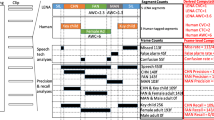Abstract
The Human Speechome Project is an effort to observe and computationally model the longitudinal course of language development for a single child at an unprecedented scale. We are collecting audio and video recordings for the first three years of one child’s life, in its near entirety, as it unfolds in the child’s home. A network of ceiling-mounted video cameras and microphones are generating approximately 300 gigabytes of observational data each day from the home. One of the worlds largest single-volume disk arrays is under construction to house approximately 400,000 hours of audio and video recordings that will accumulate over the three year study. To analyze the massive data set, we are developing new data mining technologies to help human analysts rapidly annotate and transcribe recordings using semi-automatic methods, and to detect and visualize salient patterns of behavior and interaction. To make sense of large-scale patterns that span across months or even years of observations, we are developing computational models of language acquisition that are able to learn from the childs experiential record. By creating and evaluating machine learning systems that step into the shoes of the child and sequentially process long stretches of perceptual experience, we will investigate possible language learning strategies used by children with an emphasis on early word learning.
Preview
Unable to display preview. Download preview PDF.
Similar content being viewed by others
References
Tomasello, M., Stahl, D.: Sampling children’s spontaneous speech: How much is enough? Journal of Child Language 31, 101–121 (2004)
Roy, D., Pentland, A.: Learning words from sights and sounds: A computational model. Cognitive Science 26(1), 113–146 (2002)
Roy, D.: Semiotic schemas: A framework for grounding language in action and perception. Artificial Intelligence 167(1-2), 170–205 (2005)
Gorniak, P.: The Affordance-Based Concept. PhD thesis, Massachusetts Institute of Technology (2005)
Fleischman, M., Roy, D.: Why are verbs harder to learn than nouns? Initial insights from a computational model of situated word learning. In: Proceedings of the 27th Annual Meeting of the Cognitive Science Society (2005)
Roy, D., Patel, R., DeCamp, P., Kubat, R., Fleischman, M., Roy, B., Mavridis, N., Tellex, S., Salata, A., Guinness, J., Levit, M., Gorniak, P.: The Human Speechome Project. In: Proceedings of the 28th Annual Cognitive Science Conference (2006)
Author information
Authors and Affiliations
Editor information
Editors and Affiliations
Rights and permissions
Copyright information
© 2006 Springer-Verlag Berlin Heidelberg
About this paper
Cite this paper
Roy, D. et al. (2006). The Human Speechome Project. In: Vogt, P., Sugita, Y., Tuci, E., Nehaniv, C. (eds) Symbol Grounding and Beyond. EELC 2006. Lecture Notes in Computer Science(), vol 4211. Springer, Berlin, Heidelberg. https://doi.org/10.1007/11880172_15
Download citation
DOI: https://doi.org/10.1007/11880172_15
Publisher Name: Springer, Berlin, Heidelberg
Print ISBN: 978-3-540-45769-5
Online ISBN: 978-3-540-45771-8
eBook Packages: Computer ScienceComputer Science (R0)




